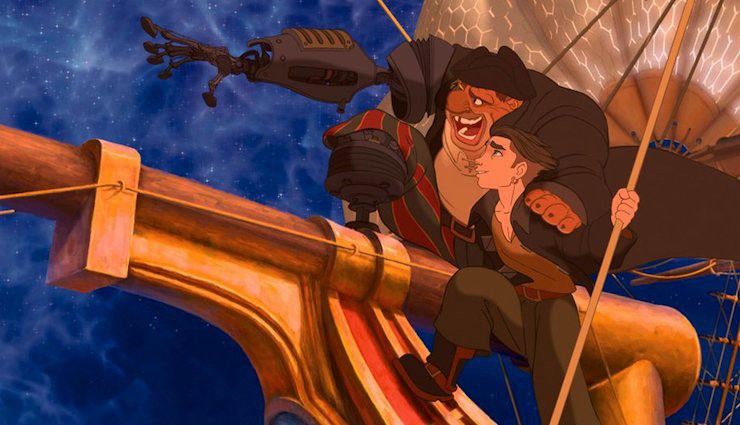Let’s skip back a moment, to 1985:
Writer/directors Ron Clements and John Musker: Pirates! In! Space!
Chairman of Walt Disney Pictures Jeffrey Katzenberg: No.
Ron Clements and John Musker: But! Pirates! In! Space!
Jeffrey Katzenberg: What about this “Great Mouse” thing you’ve been talking about? That sounded cute. And topical!
Or, to another moment, in 1987:
Ron Clements and John Musker: Pirates! In! Space!
Jeffrey Katzenberg: Or mermaids! In water!
Or to another moment, in 1990:
Ron Clements and John Musker: Pirates! In! Space!
Jeffrey Katzenberg: Still no.
Or to this moment, in 1993:
Ron Clements and John Musker: Pirates! In! Space!
Jeffrey Katzenberg: Really, guys—
Ron Clements and John Musker: Did you not see the live action Treasure Island this studio did decades ago? Or more specifically, how well it did at the box office?
Jeffrey Katzenberg: I did. You know what else did well at the box office?
Ron Clements and John Musker: Our last three films?
Jeffrey Katzenberg: Ok, true, but still. No.
Ron Clements and John Musker: Pleeeeeaaaaaaaaaaaaaaaaaaaassse!
Jeffrey Katzenberg: Get me another hit film, and then, maaaaaybe.
And then, 1998:
Ron Clements and John Musker, taking a deep breath: Pirates! In! Space!
Disney executives: Is there any way we can persuade you to drop this?
Ron Clements and John Musker: No. We love pirates. And treasure. And space!
Disney executives: Sigh.
It wasn’t that Clements and Musker disliked the films Disney assigned to them—The Great Mouse Detective, The Little Mermaid, Aladdin, and Hercules. But they really wanted to do their dream project: an adaptation of Treasure Island, set in space, but with space ships that looked like pirate ships. They had concept art, character sketches, a plot, and a dream. It had been one thing when the still unknown filmmakers had been assigned to The Great Mouse Detective instead of their dream film, and even The Little Mermaid. But as the box office results for the very successful Aladdin rolled in, Clements and Musker got impatient. They’d done what Disney wanted for three films. Now they wanted to do their dream film. Katzenberg was still unconvinced, but finally made a deal with them: if they did one more lighthearted, amusing film, they could have their pirates in space.
Reluctantly, the two set to work on Hercules.
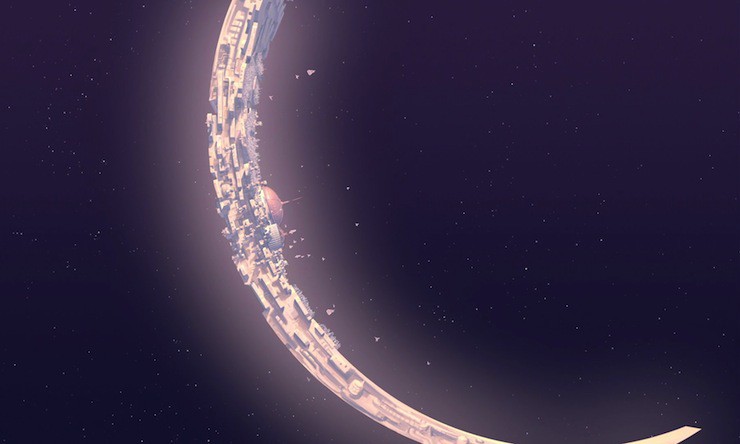
By the time they were done, Katzenberg had left Disney to form Dreamworks Pictures. His successors at Disney were equally unenthusiastic about pirates and space. By this time, however, Clements and Musker were adamant. They had made four films for Disney that had all been box office hits. They deserved to make their dream film. Disney executives finally yielded, and the writer/directors plunged into a project that essentially proved a harsh truth: every once in awhile, you really shouldn’t follow your dreams.
Because I’m about to get very harsh on this film, which is a cult favorite, a few quick points here: Treasure Planet is not a complete failure, unlike some of the other films discussed in this Read-Watch. It is unquestionably beautiful to look at, with daring and imaginative images—my favorite, perhaps, is the space ship port contained in a small crescent moon, but Treasure Planet has any number of wondrous images that I could have chosen from, including the treasure map at the center of plot, which opens to reveal a glorious map of stars. The multi-layered, central relationship between Jim, the main protagonist, and Long John Silver, the space pirate who both befriends and betrays him, is one of the richest and most convincing relationships Disney ever animated; if the entire film was nothing but the two of them, I would have no complaints at all. Unfortunately, it isn’t, but more of that in a bit.
Also, I love little Morph, Long John Silver’s little alien pet that can shift into various shapes at will. (Thus, Morph.) He’s cute, and I want one.
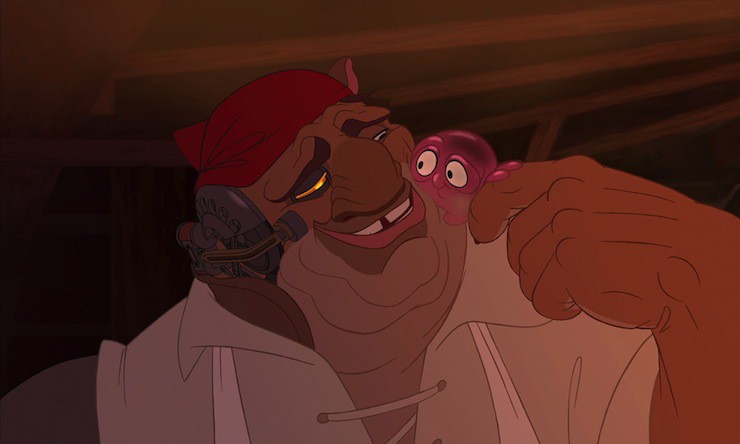
And now, the rest.
Treasure Planet opens on a note of combined rebellion and freedom, possibly a reflection of what Clements and Musker felt at this point, as Jim decides to do some solar surfing. This mostly serves as an opportunity for the filmmakers to assure viewers that the animation here would be as spectacular as it was in previous films: a combination of hand drawn animation and Disney’s Deep Canvas software, which had been used to such outstanding effect in Tarzan. Clements and Musker wanted Treasure Planet to have same sort of camera work as a James Cameron or Steven Spielberg film, which meant moving the camera a lot, which in turn forced animators to depend not just on the Deep Canvas software, but on small statues of every character that could be quickly rotated as references.
(As a bonus, the small statues were later put on display at Disney MGM-Studios as part of the Animation attraction; Disney would begin to do the same with many later productions. They are impossible to find now, but Disney cast members are hopeful that they will make an appearance someplace in the Hollywood Studios park once the current Star Wars and Pixar expansion is complete.)
The focus on moving the camera led to another innovation: designing 360 degree backgrounds, in contrast to the generally flat, partial backgrounds seen in previous Disney films. A few scenes—Belle’s dance with the Beast, the swooping camera work in the opening scene of The Lion King, and the Firebird sequence in Fantasia 2000—had come close to allowing a circling camera, but never completely achieved a full 360 background; Treasure Island perfected this, allowing the rooms of the pirate ship and space station to be seen from every angle. These backgrounds were innovative for another reason: for the first time ever in a Disney film: they are entirely digital, if based on 19th century oil paintings and the hand drawn illustrations from some of the earliest printings of Treasure Island. With added stars and nebulas, because, outer space.
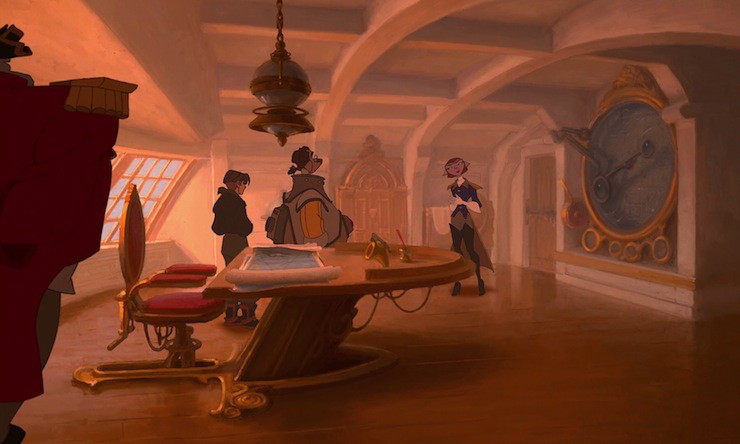
Animators also relied on computers to help animate Long John Silver’s various appendages. They also used computers to help animate B.E.N., a robot whose artificial intelligence has gone a bit offline, Treasure Planet’s by now almost mandatory Professional Comedian Sidekick (in this case, voiced by Martin Short.) He’s not quite as entertaining as the original Ben in Treasure Island, but he does tell more jokes, so that’s something.
Otherwise, however, the filmmakers relied on good old fashioned hand drawn animation. Given the sheer number of characters with different body shapes and complicated costumes, this meant hiring an unusually high number of animators, which added to the expense of animating an already expensive film. In the end, this would be Disney’s most expensive animated film to date.
Which is why it’s kinda sad that so much of it makes no sense.
I mentioned, for instance, the image of the city nestled in the crescent moon. Beautiful, imaginative, a spectacular shot, one I’d be all about except for a lot of questions:
- Where is this moon?
- How is it holding its crescent shape? Moons generally come in two shapes: round, if they are large and heavy enough, and not round, if they are not. If they are not, they are generally not shaped like perfect crescent new moons, lovely though that image is. This moon is apparently only the size of a single city—let’s say Manhattan—so not that large, which brings up the next question: how does it have enough gravity to keep everything on its surface, especially since multiple people are walking around not at all bolted down, and the artificial gravity on the spaceship docked at this city doesn’t need to get turned on until the ship leaves the city, and also, how is anyone breathing?
The reason I end up asking these questions is that later, this film wants me to take the science seriously, throwing in an unexpected encounter with a supernova, necessary for the narrative so that Jim will later know how to save the ship from a collapsing portal thing, and a scene where the gravity on the ship gets turned off and on. Speaking of that gravity off and on scene, if the gravity is turned off, and they are in deep space, which apparently they are, based on the lack of gravity, although they are also floating above a giant space station large enough to have vegetation covering its surface (MOVING ON) and NOBODY IS IN A SPACE SUIT then HOW IS ANYONE BREATHING? And speaking of all of this, ok, yes, the sails LOOK awesome but exactly what are they doing and what space winds are they flying on, exactly?
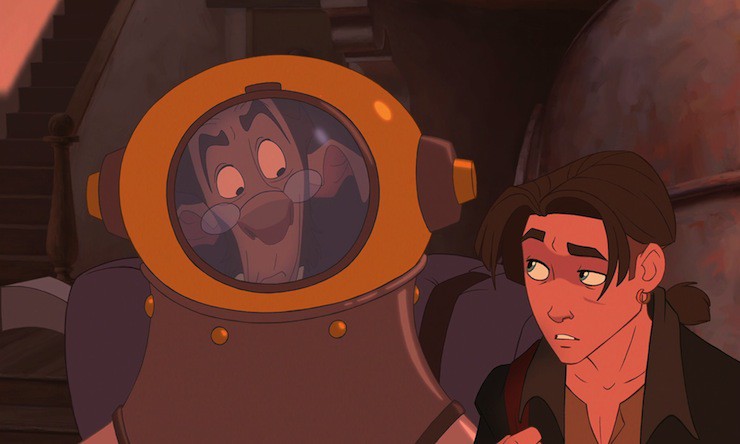
Treasure Planet, of course, came after a long, long string of space opera films that happily ignored science (Star Wars and your sequels, we are primarily looking at you), and the steampunk town nestled in a crescent moon where everyone breathes freely is hardly the worst violation of physics in film history (I’d jump on you, Cloud City in Empire Strikes Back, but let’s face it, you were hardly the worst example either). It’s also part of a long series of animated films that often ignored the rules of basic physics (hi, Tarzan). Had Treasure Planet stayed in that mode, I expect things would have been fine, but unfortunately, despite mostly trying to ignore physics, the film also has at least four separate scenes using physics for plot. It creates a disjointed effect.
Also disjointed: many of the jokes in the film, including, for instance, a Star Trek joke, and a moment when B.E.N. sings “A Pirate’s Life For Me.” They’re meant to be the same sort of joking references to contemporary culture that had filled Aladdin and Hercules. But while this worked well for the self-aware and never particularly serious Hercules, and for the magical, not entirely part of his world in the first place Genie of Aladdin, here, it works less well. First, Treasure Planet is not a comedy, let alone a self-aware one. Second, the jokes are told by multiple characters, none of whom have any reason to refer to contemporary culture. If Treasure Planet had stuck to one or two of these jokes, it might have worked, but the awkward contemporary references against the deliberate 19th century design against outer space creates a feeling of, well, awkwardness.
But the biggest problem is that Treasure Planet takes a story that, for all its adventure and pirate fantasies, remains strongly grounded in realism, and transforms it into an outer space adventure with no realism at all. In Treasure Island, the characters have to deal with corpses, poorly made boats, the logistics of getting the treasure back to Britain without everyone stealing it, and limited stores of food, water and ammunition. Characters get sick, drunk, pass out, and die. That—and the high death count—adds not just a realistic touch, but a genuine note of suspense and tension.
Three characters do die in Treasure Planet—but we don’t get to know any of them, and none of them, even the upright, honorable Arrow, get a lot of mourning. This isn’t just in contrast to the book, but is also in stark contrast to other Disney animated films, which usually feature sadness and crying whenever anyone dies, even when that character returns to life just moments later. Oddly, those fake-out deaths end up having a larger emotional impact than the deaths here, largely because of the muted emotional reaction. Here, since almost nothing has an emotional impact, very little feels real.
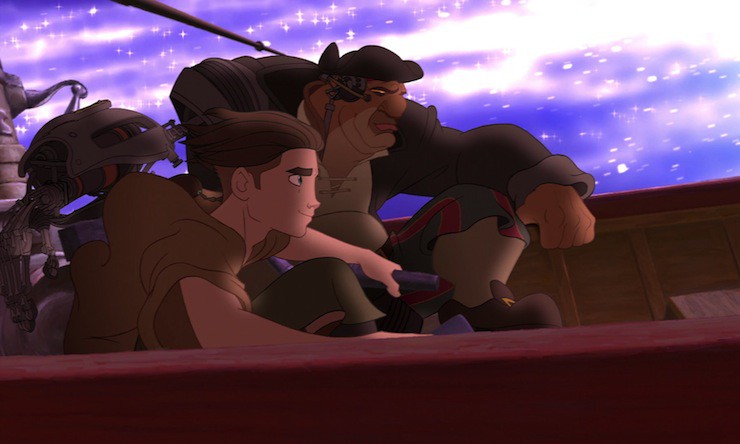
The one exception is the relationship between Long John Silver and Jim. It’s a testament to Stevenson’s creation that Long John Silver transitions so fluidly into this film: he’s the hands down best and most intriguing part of it, as he was in the original book, and not just because of his great line about an eyeball. He’s also the centerpiece of the best relationship in the film, the father-son bond of sorts he develops with Jim, transformed in this film from an honorable, upright boy to a troubled boy still angry that his father abandoned him. Starting, as it does, with mutually suspicious dialogue before shifting into a wary trust, in some ways it works even better than it did in the original book, which did not really bother to waste time on developing any relationships, father/son or otherwise. Here, the relationship helps explain Long John Silver’s shifting alliances, as well as Jim’s decision not to abandon him in return. It helps that Long John’s advice to Jim is actually good advice—better than the advice Jim gets from his other quasi father figure, Doppler, or indeed from anyone else in the film. Not surprisingly, Long John becomes one of the few people Jim will listen to. Until he meets the robot, but that’s less “listening to” and more of “trying to make sense of so I can find this treasure and a way off the planet.”
Unfortunately, the other relationships in the film tend not to fare as well. For instance, the film starts out lightly teasing the possibility of some sort of future relationship between the dog-like Doppler, apparently an old friend of the family, and Jim’s mother, something that gets completely dropped when Jim and Doppler decide to go after the treasure. They leave Jim’s mother behind, and mostly out of the film. Doppler then meets Captain Amelia, who has to correct him on multiple items, something he resents. They then barely interact at all for several scenes, exchange one significant and completely unearned glance at the film’s climax, and show up in the final frames, married, with quadruplets. I suspect there’s more here—something about dog and cat people biology, possibly, some slight visual joke that isn’t translating that well to the screen—but the bottom line is that I ended up feeling that maybe, just maybe, I’d been a little harsh about some of the previous “what setup” romantic relationships in Disney films. At least Cinderella and Snow White assured us that their princes were charming sorts of people. Here, we’ve had some resentful dialogue, and then, quadruplets.
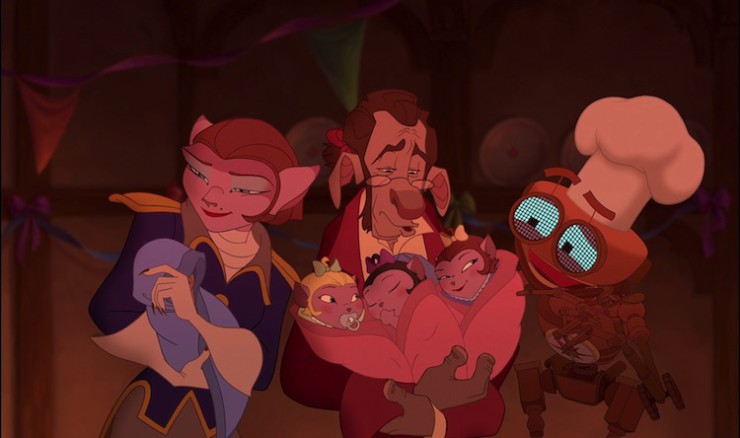
Speaking of those relationships, I do find one more thing about Treasure Planet odd—not bad, certainly, but odd. By the time they started work on Treasure Planet, Musker and Clements had gained a certain reputation for featuring heroines tinged with more than a bit of eroticism. The cabaret song sequence in The Great Mouse Detective had almost gotten that otherwise adorable and inoffensive film a PG rating. Jasmine and Meg are regularly listed among the most “sexy” Disney characters, with Ariel not that far behind. Both Ariel and Meg are required to seduce the heroes of their films, and Jasmine uses seduction to distract the villain in hers. Treasure Planet retreats from this. The film has exactly two women: Jim’s mother and Captain Amelia. Both remain fully and modestly clothed in every scene; neither woman tries to seduce anyone, and although, as I noted, both are somewhat involved in relationships, “tacked on at the last minute” seems somehow a bit too kind a description for Captain Amelia, and Jim’s relationship with his mother is considerably less important to him, and to the film, than the relationships he develops with Long John Silver and B.E.N. the robot.
And Treasure Planet is unusual in another way: it’s one of only two Disney animated films not to have a romance for a protagonist old enough to have one. Disney had, of course, produced a number of non-romantic films—Pinocchio, Dumbo, Peter Pan, Alice in Wonderland, The Sword in the Stone, The Many Adventures of Winnie the Pooh, The Great Mouse Detective, Oliver and Company and Lilo and Stitch – but all of these had featured younger protagonists.
The other exception, The Emperor’s New Groove, features a happily married couple and whatever Yzma and Kronk are—that’s not clear. Treasure Planet has no happy couples, until the unexpected significant look and the quadruplets at the end, and no real romance—quite possibly why those quadruplets were thrown into that final scene.
But they were not enough to save the film. Treasure Planet debuted to kind to lukewarm reviews, but even with the kind reviews, viewers apparently did not want to see pirates in space. Even pirates making the occasional Star Trek joke and singing “Yo Ho Ho Ho a Pirate’s Life For Me In Space.” Treasure Planet bombed at the box office when it was finally released in November 2002, earning only $38 million in the United States. International receipts only bumped that total up to $110 million. DVD and later streaming releases did little to improve these figures.
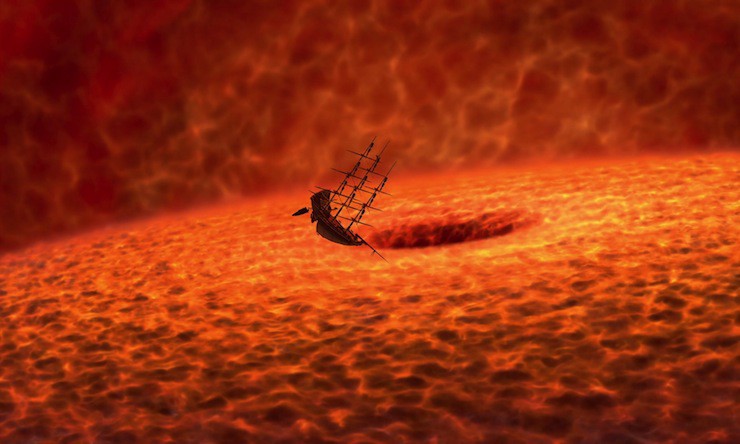
Officially, the film cost $140 million to make (actual costs are rumored to be considerably higher), with marketing costs bringing this up to $180 million (actual costs are again rumored to be considerably higher) making Treasure Planet not only the worst performing Disney animated film in years, but, as of this writing, the worst performing Disney animated film of all time, managing to lose more money, even adjusted for inflation, than previous box office flops The Black Cauldron and Sleeping Beauty—combined. As of this writing, it is still listed as one of the most expensive box office flops of all time. Worse, The Black Cauldron had at least managed to recoup costs in international releases, and Sleeping Beauty, of course, had eventually more than recouped its costs in later releases and as part of the Disney Princess franchise. Treasure Planet had little hope of doing either.
The financial news could not have arrived at a worse time for Disney, then mired in executive infighting that did not end until 2005. Or for Disney Animation, which by this time, with the sole exception of Lilo and Stitch, had suffered through a solid decade of slowly declining box office receipts and critical praise, and was now contending with not one, but two successful rival animation studios. That one of these rivals, Pixar, had developed its earlier animation programming while working with Disney, and that the other rival, Dreamworks had been in part founded by former chairman of Walt Disney Studios Jeffrey Katzenberg (see why I name dropped him earlier?) only made the situation more painful—especially since Katzenberg had been deeply skeptical of the Treasure Planet project to begin with.
By this point, Roy E. Disney, Michael Eisner, and other Disney executives did not agree on much. Indeed, they agreed on so little that Roy E. Disney was already starting the process that would lead to Eisner’s ousting. But, as the executives before them had right after Sleeping Beauty and The Black Cauldron, Disney, Eisner and other executives did agree that their animation department had a problem. They looked at the box office success of their rivals at Pixar and Dreamworks. They noticed a common factor. No, not well told stories, or popular characters, or even Buzz Lightyear.
Computer animation.
Dismissing the traditionally animated Lilo and Stitch as an outlier, Disney executives made a momentous decision:
Going forward, the studio would—with one exception, to be discussed in a few more posts—stop creating traditional, hand drawn animation, the very art form that Disney animators had focused on since the creation of Mickey Mouse, the art form they had transfigured into full length animated films, the art form that they were still selling (in the form of hand drawn, hand inked and painted cels) in their theme parks, the art form that had, for all intents and purposes, launched their company.
A history ended with a single pirate film.
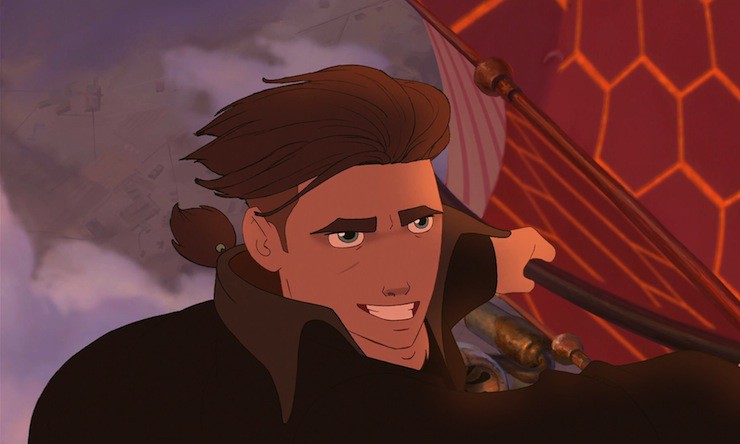
Instead, the studio would follow the lead of the rivals it had helped create.
Which means it’s time to skip a couple more films:
Brother Bear is a Disney original. Notably, it’s one of the few films to change aspect ratios midway through the film, an effect somewhat lost on the Netflix transfer. Watch this on Blu-Ray. It was also the last film animated at Disney’s Florida animation studio. Traditionally animated, it did decently enough with critics, the box office and later merchandise sales (you can still find related clothing and pins), but ended up being completely overshadowed by a little film called Finding Nemo.
Home on the Range is another Disney original. It’s not exactly one of the better Disney animated films, but if you ever woken up at 3 am thinking, wow, I really want to hear Dame Judi Dench voicing a cow, then this is your film. Traditionally animated, Home on the Range struggled through development, going through multiple pitches and storyboard treatments before switching directors mid-animation. It performed poorly at the box office, failing to earn back its production costs, and ended up getting completely pounded by a little film called The Incredibles.
Next up: Chicken Little, a film that appeared in 2005—one of the few years of that decade without a Pixar film.
Mari Ness lives in central Florida.










